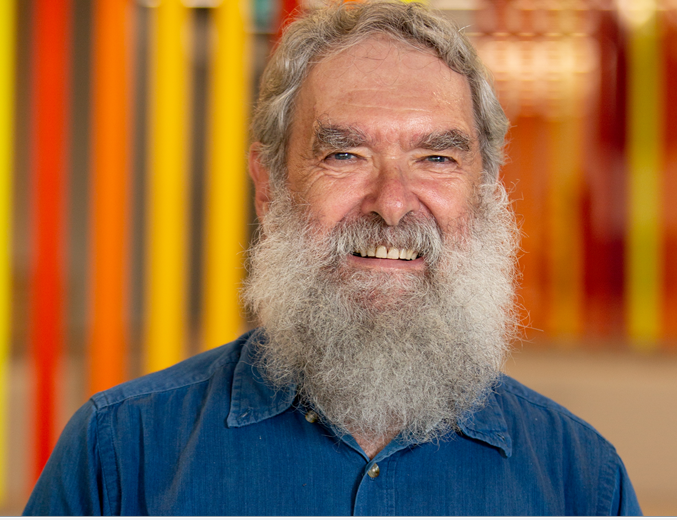
My Expertise
Analytical chemistry, electrochemistry, metrology, quality assurance, chemometrics, corrosion, sensors, electronic noses, drug detection, scientific fraud, cranks, computers in chemistry, forensic science
Keywords
Fields of Research (FoR)
Electrochemistry, Electrochemical energy storage and conversion, Analytical chemistry, Forensic chemistry, Analytical Chemistry, Quality Assurance, Chemometrics, Traceability and Metrological Chemistry, Sensor Technology (Chemical aspects)SEO tags
Biography
Emeritus Professor Hibbert FRSN AM occupied the Chair of Analytical Chemistry at the University of New South Wales in Sydney from 1987 until his retirement in 2013. He is presently (since 2020) Honorary Dean of Emeriti.
His research interests are in electroanalytical chemistry and chemometrics and metrology in chemistry, but he also does a side line in expert opinion, scientific fraud and presenting science to the public.
He has published...view more
Emeritus Professor Hibbert FRSN AM occupied the Chair of Analytical Chemistry at the University of New South Wales in Sydney from 1987 until his retirement in 2013. He is presently (since 2020) Honorary Dean of Emeriti.
His research interests are in electroanalytical chemistry and chemometrics and metrology in chemistry, but he also does a side line in expert opinion, scientific fraud and presenting science to the public.
He has published around 300 papers, 6 books and 3 patents. Notable books are, Data Analysis for Chemistry: An Introductory Guide for Students and Laboratory Scientists (Oxford University Press, New York, 2005, 192 pp) written with Justin Gooding, and Quality Assurance in the Analytical Chemistry Laboratory, published by Oxford University Press in 2007. Professor Hibbert won the Ollé Prize of the RACI in 2008 for this text.
He is past Chair of the Analytical Division of the RACI, past chair of the IUPAC Analytical Division, and past president of the Royal Society of New South Wales. He is currently the Secretary of the Interdivisional Committee for Terminology, Nomenclature and Symbols of IUPAC, and editor of the Orange Book (Compendium of Terminology in Analytical Chemistry), which was published in 2023 after 14 years of preparation. Professor Hibbert is also a member of advisory committees for NATA and represented IUPAC at the JCGM-WG1 which is responsible for the Guide to the “Expression of Uncertainty in Measurement”.
In 2018 he became a member of the Order of Australia (AM) for “significant service to science in the discipline of chemistry, to professional societies, and to sport through illicit drug profiling”
My Grants
- 1988/89 :Organic electrochemistry at transition metal oxide electrodes $36000.
1988/89 Field electron emission from electrolytic conductors $28000.
1989 Electron spin resonance spectrometer $200000 (with colleagues from Sydney Uni).
1990/91 Surface Analysis Facility $150000 (with others).
1990-1 Multiple ion selective electrodes $34000 (with PW Alexander).
1991-3: Electrochemically deposited fractals $155000
1993-5: Optimisation of Ion Chromatography using artificial intelligence (with Haddad and Compton) $95 000
1994-6: Pattern formation and growth $155000
1994-6: Multielectrode flow through sensor (with Alexander) $161000
1996-8: Expert system for ion chromatography (with Haddad, Mulholland and Compton) $120,000
1997-9: Sources and propagation of errors in analytical chemistry (with Mulholland) $135,000
2002-4 A multi-metal ion sensor for analysis of environmental water (with Gooding) $150 000
2003-5: Preparation of nanostructured surfaces by electrochemical deposition through lyotropic liquid-crystal templates $145000
2005-7: Development of stable, patterned Self-Assembled Monolayers on carbon for sensors and other nanotechnology applications (with Quinton) $164000
2006-8: Multivariate approaches to matching spectra for environmental and forensic purposes $267000
2011-2013 Maximum entropy methods for Bayesian analysis in chemistry, $300,000
2013 – 2015 DP130100526 Heat-resisting iron-nickel base alloys in challenging new applications – oxygen permeabilities and resistance to internal oxidation, (with Young, Zhang) $460,000
2015 – 2018 LP140100403. Conformal Bionics - addressing the challenges in bringing miniaturised implants to the site of therapeutic delivery, (with Suaning et al.) $372,000
2015 – 2017 Miniaturised Ionic liquid Systems: Design, Electrochemistry and Application $400,000 (with Chuan Zhao)
2021 – 2023 Advanced electrocatalysts for ammonia synthesis with validated analysis $430,000 (with co-CI Chuan Zhao)
My Qualifications
1969-1972 BSc with First Class Honours in Chemistry, King's College,
1972-1975 PhD in Physical Chemistry, King's College,
Title of thesis: Chemical Aspects of the electric discharge, the silent electric discharge and the field induced discharge.
Supervisor: Professor A.J.B. Robertson
My Awards
1970 Sambrooke Exhibition
1971 Samuel Smiles Prize
1972 Neil Arnott Prize, J. Millar Thomson Medal.
1999 RACI Analytical Division Medal
2006
2007 RACI Olle Prize
2014 UNSW Mellor Medal and Lectureship
2018 Member of the Order of Australia (AM)
2019 RACI essay competition (https://www.raci.org.au/events-awards/stories-from-the-periodic-table/iodine-by-brynn-hibbert)
2019 RSNSW Medal for meritorious contributions to the Society. https://royalsoc.org.au/awards/royal-society-of-nsw-medal#recent
2019 Work on cobalt in racing recognised by ARC/ERA as “high impact” on society. (https://www.science.unsw.edu.au/research/technology/cobalt-threshold)
2021 CITAC best paper award for 2021. (With Francesca R. Pennecchi, Aglaia Di Rocco, Ilya Kuselman, Michela Sega).
2021 Emeritus Fellow IUPAC
2023 Leighton Memorial Medal of the RACI. “Awarded in recognition of eminent services to chemistry in Australia in the broadest sense.”
My Research Activities
I work with Professor Chuan Zhao and Scientia Professor Justin Gooding in the School of Chemistry.
My interests over many years have been:
Metrology in Chemistry Quality assurance in chemistry. Calibration of analytical measurements. Metrological traceability and comparability of measurement results. Measurement uncertainty. Quantitative nuclear magnetic resonance spectroscopy.
Chemometrics and statistics Use of Bayes theorem in chemistry. Multivariate analysis of GC data from Australian plants. Distributions and fitting of analytical data.
Electroanalytical chemistry Multiple ion selective electrodes in series. Sensors. Novel ion selective electrodes. Enzyme electrodes and biosensors
Electrochemistry Hydrogen and oxygen electrochemistry – fuel cells and energy storage. Copper deposition and electrochemically generated fractals. Electrochemistry of implanted electrodes. Corrosion. Electrochemistry of perovskites and spinels. Superconductors. Organic electrochemistry. Ammonia synthesis by electrochemical nitrogen reduction.
Forensic chemistry Reliability of expert evidence. Definition of analogue drugs. Manufacture of drugs, including amphetamines.
Surface physics Field electron emission and exoelectron emission from glasses and electrolytic conductors
Chaos theory Dynamics of markets. Non-linear systems in chemistry. Agent based modelling.
Gas sensors ‘Electronic nose’ used for environmental monitoring , health, process control
Drug detection Ionscan equipment used in drug detection. Heroin signature program. Amphetamine manufacture and detection.
My Engagement
I appeared on television and radio a number of times in the 1990's, giving interviews or longer pieces on pollution (our gas monitor), fractals and chaos, and on scientific fraud. In 1994 I put together a segment for the children’s science show “Hot Science” on Channel 9. This went to air in January 1995.
In 1998 and 1999 I was invited to give a New Sceintist lecture as part of Australian Science Week - Crooks Cranks and Conspiracies
In 1998 I appeared on the ABC Quantum program who did a feature on our “electronic nose”
Mentions of my work on doping in the racing industries include:
Jan 19, 2015 “The Cobalt Threshold - How it was determined” https://www.racing.com/news/2015-01-19/the-cobalt-threshold ;
Dec 1, 2017 “Study Shows Arsenic And Cobalt Levels Dropping – GRNSW” http://www.grnsw.com.au/news/study-shows-aresenic-and-cobalt-levels-dropping-
Dec 5, 2014 “Darren Smith's horses cobalt reading off the scale”, https://www.smh.com.au/sport/racing/darren-smiths-horses-cobalt-reading-off-the-scale-20141205-121bte.html
Oct 16, 2015 “Million-to-one chance of raised cobalt levels occurring naturally” https://www.theaustralian.com.au/sport/horse-racing/milliontoone-chance-of-raised-cobalt-levels-occurring-naturally/news-story/63a0a195fbeceb30f2b7c57b85594ad9
Publications
ORCID as entered in ROS
Research Activities
The project will develop a robust approach to use maximum entropy methods to model likelihood functions for a Bayesian analysis of chemical data. This will allow values and confidence intervals to be obtained from chemical measurements that are better (more statistically valid) than those obtained by present methods. The new approach will be applied to important current problems in chemical measurement: the uncertainty of atomic weights of elements, limits on the detection of illegal drugs, and for sports drug testing.
The project will develop a robust approach to use maximum…
